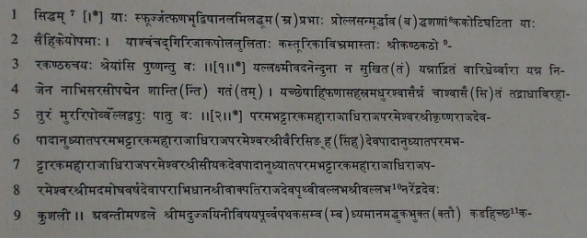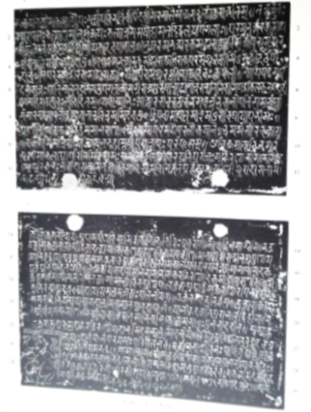|
The Indian Analyst
|
North Indian Inscriptions |
INSCRIPTIONS OF THE PARAMARAS OF MALWA With the customary imprecatory verses which are the same as to be found in the other grants of the king, and with the usual expressions maṁgalaṁ mahā-śrīḥ, the record comes to a close. ...Of the geographical names found in the inscription, Ujjayani (1. 9) [1] is the well-known city of Ujjain ; it is mentioned here as a vishaya, a smaller territorial unit which was included in the maṇḍala of Avantī (1. 9), which was a larger administrative division. It is interesting to note here the relative significance of both these terms. Pūrva-pathaka (1. 9) [2] is possibly used to denote a sub-division of the vishaya, and was situated in the east, in contrast with the expression ‘paśchima-pathaka’, used in the Dharampurī grant of Vākpati, issued in V.S. 1031, [3] Maddhuka (1.9) which is stated here to be a still smaller division(bhuki), cannot be identified ; but Dikshit’s suggestion ‘that it may perhaps be identified with Mahū or Mhow, the well-known cantonment near Indore,’ appears to be unacceptable, for, besides his own statement that it would be about 40 miles, i.e., 64 kms. from Narwal, the place is to its south-west and straight to the south of Ujjain,’ and not to its east, as indicated in the inscription. The gift-village Kaḍahichchhaka (1.9) has rightly been identified with Karcha or Kaḍacha, almost 5 kms. to the north of Narwal and almost equi-distant to the north-west of Gaonri. [4] Abhrasarīt (1. 12), where the king took his bath before making the gift, cannot be indentified ; it appears, however, to be possible that abhra is wrongly engraved for ambhaḥ, meaning water, and the name of the river was omitted through inadvertence, as stated above. ... TEXT
[5]
[1] The spelling of this word is interesting ; the same spelling appears in some other grants of the Paramāra
kings. Cf. Bhōja’s Ujjain grant of V.S. 1076 (11. 6-7). Moreover, the name Avantī denoting West Mālwā
reminds us of the earlier times (Ākar-āvantī).
..............CORPUS INSCRIPTIONUM INDICARUM
|
||||||||||||||||||||||||||||||||||||||||||||||||||||||||||||||||||||||||||||||||||||
| > |
|
>
|









